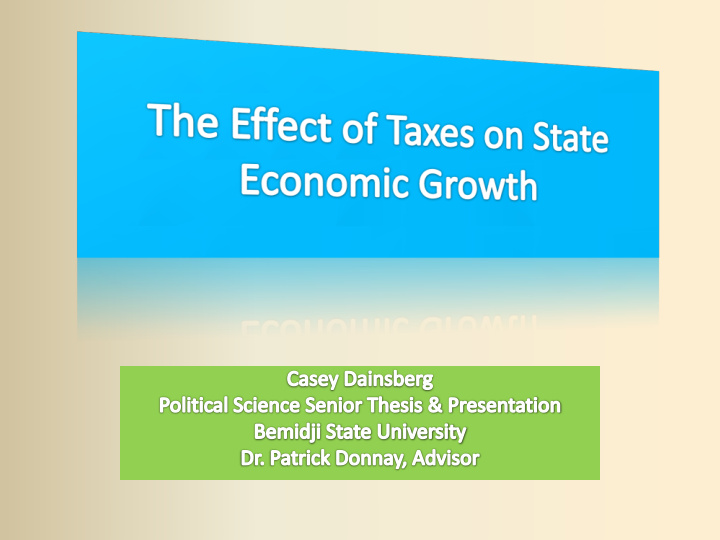



The Current Crisis The problem: Economic unrest (High unemployment rates, Housing Market etc…) Unsustainable Debt (Currently above $14 Trillion) How do we fix it? Two Theories: 1. Increase Taxes 2. Decrease Taxes So which one works?
Do states with higher taxes have more economic prosperity? Or, do states with lower taxes have higher economic prosperity? In a comparison of States, those with lower taxes will experience more economic growth than states with higher taxes.
Previous Findings • Part One: Findings regarding the effect of taxes on economic growth is mixed 1. Research differences 2. Time Differences • Big Picture – Taxes do have an effect on the economy – Some taxes have more effect than others • Lee, Gordon (2005) Corporate Income Taxes/Personal taxes • Milesi-Ferretti, Roubin (1998) Consumption Taxes, and Income taxes • Helms (1998) & Mofidi, Stone (1990)
Current Research • What makes this research different? • Independent Variables: – Sales Tax – Individual Income Tax – Corporate Income Tax – Property Tax
Previous Findings Cont… • Part Two: Economic Indicators • Measuring the taxes effect on the economy- o GDP (Gross Domestic Product): Scully (2006) o Employment/Unemployment : Wasylenko, McGuire (1985) o Poverty: Roemer, Gugerty (1997)
Current Research • Dependent Variables: 1. State GDP (Gross Domestic Product) 2. Unemployment Rate 3. Poverty Rate
Data & Measurements (IV) • What to study: Unit of Analysis are the 50 U.S. States between 2001-2009 • Creating Variables: – Independent Variables: • Tax Revenue Data from U.S. Census Bureau for 2001 & 2009 (Units were in thousands of dollars) • Subtracted 2001 revenue from 2009 revenue-represents the change in taxes (growth or decline) over the eight years. • Divided by estimated population (U.S. Census Bureau) • Result: Variables representing the change in tax over the eight year period, Per Capita.
Data & Measurements (DV) • Creating Variables Cont… – Dependent Variables • Unemployment Rate for 2001 & 2009, Bureau of Labor Statistics • State GDP in current dollars (in millions) for 2001 & 2009 from Bureau of Economic Statistics • Poverty Rate for 2001 & 2009 from the U.S. Census Bureau • Subtracted 2001 values from 2009 to obtain the change over the eight year period. • Divided GDP change by estimated population to make it Per Capita (Unemployment and Poverty Rates excluded)
Table 1.1 Regression Analysis: Impact of States Sales tax on Economic Growth Indicators (T-Statistics in Parentheses) Unemployment Poverty GDP Bivariate Regression Standardized coefficient Standardized coefficient Standardized coefficient Sales Tax -.193 (-1.362) -.399 (-3.0184)* .575 (4.872)* R Square .037 .159 .331 Adjusted R Square .017 .142 .317 Multivariate Regression Standardized coefficient Standardized coefficient Standardized coefficient Sales Tax -.168 (-1.248) -3.94 (-2.842) * .559 (4.785) * Democratic Legislators .793 (1.990)*** .305 (.745) -.649 (-1.880) Percentage of African Americans -.425 (-1.057) -.152 (-.369) .493 (1.414) College Education or Higher -.048 (-.333) -.164 (-1.122) .175 (1.148) Union Membership .233 (1.578) .027 (.177) .071 (.557) R Square .264 .222 .447 Adjusted R Square .180 .133 .384 Source: U.S. Census Bureau, Bureau of Labor Statistics, Pollock State Data Set, Bureau of Economic Statistics Significance: *p<.05, **p<.01, ***p<.1
Table 1.2 Regression Analysis: Regression Analysis: Impact of Individual Income Tax on economic growth Indictors (T-Statistics in Parentheses) Unemployment Poverty GDP Bivariate Regression Standardized coefficient Standardized coefficient Standardized coefficient Income Tax -.435 (-3.091)* -.292 (-1.954)*** .631 (5.203)* R Square .189 .085 .398 Adjusted R Square .169 .063 .383 Multivariate Regression Standardized coefficient Standardized coefficient Standardized coefficient Income Tax -.591 (-4.565)* -.255 (-1.573)*** .582 (4.521)* Democratic Legislators -.018 (-.130) -.143 (-.819) .141 (1.023) Percentage of African Americans .380 (2.985)* .241 (1.513) -.163 (-1.293) College Education or Higher .025 (.189) -.077 (-.466) .176 (1.347) Union Membership .502 (3.483)* .028 (.154) -.062 (-.434) R Square .471 .172 .478 Adjusted R Square .398 .057 .406 Source: U.S. Census Bureau, Bureau of Labor Statistics, Pollock State Data Set, Bureau of Economic Statistics Significance: *p<.05, **p<.01, ***p<.1
Table 1.3 Regression Analysis: Impact of Corporate Income Taxes on Economic growth indicators. (T-Statistics in Parentheses) Unemployment Poverty GDP Standardized coefficient Standardized coefficient Standardized coefficient Bivariate Regression Corporate Tax -.473 (-3.557)* -.239 (-1.632) .661 (5.839)* R Square .223 .057 .437 Adjusted R Square .206 .036 .424 Multivariate Regression Standardized coefficient Standardized coefficient Standardized coefficient Corporate Tax -.518 (-4.103)* -.191 (-1.245) .615 (5.404)* Democratic Legislators .012 (.082) -.161 (-.936) -.004 (-.028) Percentage of African Americans .330 (2.542)*** .173 (1.094) -.110 (-.938) College Education or Higher .034 (.253) -.103 (-.629) .142 (1.173) Union Membership .316 (2.194)*** .038 (.216) .147 (1.130) R Square .407 .123 .519 Adjusted R Square .331 .011 .457 Source: U.S. Census Bureau, Bureau of Labor Statistics, Pollock State Data Set, Bureau of Economic Statistics Significance: *p<.05, **p<.01, ***p<.1
In Conclusion • All in all the Hypothesis is not supported • Looking at specific taxes revealed certain taxes have more/less of an effect on the economy – Study suggests Individual Income tax had the greatest effect (Three dependent variables were significant), followed by Corporate Income Tax and Sales Tax. • Going Forward… – More questions than answers – Causality issues – Where to go from here: Tax Rates, State Expenditures (how revenue is spent)
Questions?
Recommend
More recommend